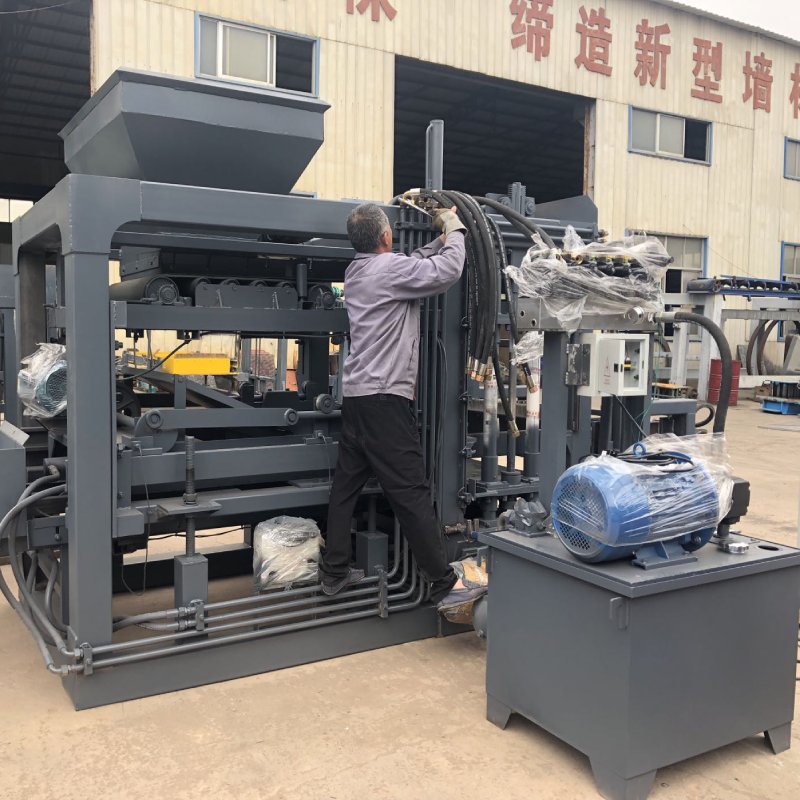
Image source Aiwei Block machine
Sustainable Block Brick Making Machines Gain Popularity.
Introduction
As the global focus on sustainable practices intensifies, the construction industry has come under scrutiny for its environmental impact. In response, engineers and innovators have been diligently working to develop more eco-friendly alternatives to traditional construction materials and methods. Sustainable block brick making machines have emerged as a promising solution to address these concerns. In this article, we will explore the growing popularity of sustainable block brick making machines, their environmental benefits, and the positive impact they have on the construction industry.
- The Need for Sustainability in Construction
The construction industry is one of the largest consumers of natural resources and a significant contributor to greenhouse gas emissions. Traditional clay brick manufacturing, in particular, involves high energy consumption and results in substantial carbon emissions. Consequently, there is a pressing need for sustainable alternatives that can reduce the industry’s ecological footprint.
Sustainable block brick making machines offer a viable solution by adopting eco-friendly production processes and utilizing recycled materials to create durable and energy-efficient bricks.
- Characteristics of Sustainable Block Brick Making Machines
a. Resource Efficiency: Sustainable block brick making machines optimize material usage, minimizing waste and conserving valuable resources. These machines often incorporate fly ash, slag, and other industrial byproducts as alternative materials, reducing the demand for virgin resources.
b. Energy Efficiency: Advanced sustainable brick making machines utilize energy-efficient technologies, such as hydraulic systems and automated processes, to reduce overall energy consumption during production.
c. Reduced Emissions: Sustainable block brick making machines contribute to lower carbon emissions by using recycled materials, reducing the need for energy-intensive clay brick production, and employing cleaner production techniques.
d. Water Conservation: Some sustainable brick-making technologies utilize dry stacking or require minimal curing, leading to water savings compared to traditional wet-mix clay brick production.
- Types of Sustainable Block Brick Making Machines
a. Compressed Earth Block (CEB) Machines: CEB machines produce bricks using a mixture of soil, stabilizers like cement or lime, and a small percentage of water. These bricks are then compressed under high pressure to form interlocking blocks. The process requires minimal energy and produces bricks with excellent thermal insulation properties.
b. Fly Ash Brick Making Machines: These machines use fly ash, a byproduct of coal-fired power plants, as a primary raw material. By incorporating fly ash into the brick-making process, the machines contribute to waste reduction and minimize the environmental impact associated with disposal.
c. Recycled Material-Based Machines: Some innovative brick-making machines utilize recycled materials like plastic, rubber, or glass as additional constituents in the brick mixture. By diverting waste materials from landfills, these machines promote circular economy principles and contribute to sustainability.
- The Environmental Benefits of Sustainable Block Bricks
a. Reduced Carbon Footprint: Sustainable block bricks made from recycled materials or industrial byproducts result in significantly lower carbon emissions compared to traditional clay bricks. These sustainable bricks help mitigate the construction industry’s carbon footprint and combat climate change.
b. Energy Conservation: Energy-efficient brick-making machines require less power during production, leading to substantial energy savings. This not only reduces operational costs but also contributes to overall energy conservation.
c. Waste Reduction: By incorporating recycled materials and industrial byproducts, sustainable block brick making machines help divert waste from landfills, reducing environmental pollution and promoting a circular economy.
d. Improved Thermal Efficiency: Sustainable bricks, such as compressed earth blocks, offer superior thermal insulation properties, reducing the need for artificial heating and cooling in buildings. This leads to lower energy consumption for climate control and increased comfort for occupants.
- Economic and Social Advantages
a. Cost-Effectiveness: Sustainable block brick making machines can offer cost savings over time due to reduced energy and resource consumption. Though the initial investment might be higher, the long-term benefits outweigh the upfront costs.
b. Employment Opportunities: As the demand for sustainable construction materials grows, the production and use of sustainable bricks generate employment opportunities in manufacturing, distribution, and construction industries.
c. Resilient Infrastructure: Sustainable block bricks produce durable, earthquake-resistant structures with enhanced resilience, leading to reduced maintenance costs and improved building longevity.
- Case Studies and Success Stories
a. India’s Fly Ash Brick Revolution: India’s construction industry has embraced fly ash brick making machines on a large scale, utilizing the abundant fly ash generated by the country’s thermal power plants. The widespread adoption of these machines has significantly reduced greenhouse gas emissions and improved resource efficiency.
b. African Compressed Earth Blocks: In regions with limited access to traditional building materials, compressed earth block machines have been instrumental in providing affordable and sustainable housing solutions. These machines have empowered local communities to build structurally sound homes and reduce their dependence on expensive imported materials.
- Challenges and Future Prospects
a. Market Acceptance: Despite the growing popularity of sustainable block brick making machines, a significant challenge lies in convincing traditional construction stakeholders to adopt these innovative technologies. Education and awareness campaigns are essential to foster market acceptance.
b. Access to Capital: The initial investment required for sustainable brick making machines can be a barrier for small-scale enterprises. Access to affordable financing and government incentives can help address this challenge.
c. Scaling Up Production: As the demand for sustainable bricks increases, scaling up production to meet market needs while maintaining quality and efficiency is crucial.
Conclusion
Sustainable block brick making machines have gained significant popularity as the construction industry seeks eco-friendly alternatives to traditional building materials. These machines offer numerous environmental benefits, including reduced carbon emissions, energy efficiency, waste reduction, and improved thermal performance. Additionally, their adoption stimulates economic growth, creates job opportunities, and enhances building resilience.
As we look towards a more sustainable future, sustainable block brick making machines will continue to play a vital role in revolutionizing construction practices worldwide. By promoting these innovative technologies, the construction industry can contribute to global efforts in mitigating climate change and achieving a greener, more sustainable world.
